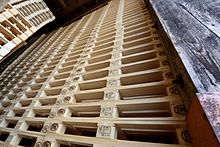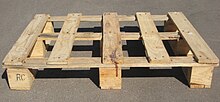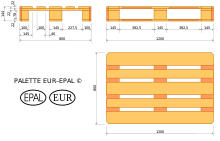Transport pallet
A transport pallet , usually called a pallet , is a flat construction of certain sizes that is used for bundling, storing and transporting larger quantities of (stackable) goods or individual, heavier items. Transport pallets are moved and loaded with floor conveyors , e.g. B. pallet trucks or forklifts . Pallets are among the transport aids .
Function, materials
When loading pallets, it is important that the goods to be transported are adequately secured against falling, for example by wrapping or shrinking them with foil.
Pallets have side recesses at the bottom that allow industrial trucks to drive their forks into the pallet in order to lift it. Most pallets are nailed together from boards and squared timber , but there are also pallets made from compressed wood, plastic , sheet metal and corrugated cardboard . A euro pool pallet weighs 20 to 24 kg (depending on the wood moisture). Pallets used in clean rooms must be washable or disinfectable.
In 2008, a total of 81 million wooden pallets were produced in Germany. The value of the pallets manufactured by the members of the German Association for Wood Packaging, Pallets, Export Packaging (HPE) was around 991 million euros in 2010.
Pallets for transporting particularly large weights are called heavy-duty pallets.
Some plastic and compressed wood pallets, as well as pallets made of corrugated cardboard, are shaped so that they can be stacked one inside the other ("nestable").
Unit Load Devices (ULD) are pallets and containers that are used to load baggage, cargo and mail onto aircraft . They consist of sheets of aluminum sheet with a substructure made of profiles, the edges of which are designed so that the eyelets of the freight nets can be snapped into them.
Disposable pallets
Disposable pallets or export pallets are intended for one-time transport from the manufacturer to the consumer and are usually not very durable. They are mostly used for export as lost packaging / pallets and remain with the recipient, who discards them. Depending on the customer's needs, they are made of wood, wood chipboard , plastic or corrugated cardboard. One-way pallets are available in all conceivable dimensions and designs. However, particularly large quantities are implemented in the formats 800 mm × 600 mm (half euro size) / 1200 mm × 800 mm (euro size) / 1200 mm × 1000 mm and in the container size 1140 mm × 1140 mm. Another standard size is 600 mm × 400 (quarter euro size) - but this is mainly used for displays .
In contrast to the reusable pallet, where different pooling systems are established on the market, there is no exchange with the one-way pallet. The last recipient in the supply chain has to dispose of the pallet. However, many countries do not want pallet pools, as this supposedly poses major problems for transport companies. Switzerland was one of the first countries to end a pallet pool on December 31, 2007 and is now mainly using one-way pallets, on the grounds that this saves companies costs.
Wooden pallets
Many countries have strict regulations to ensure that no diseases or their pathogens are hidden in the load carrier. Load carriers made of solid wood for export must therefore be specially treated ( ISPM 15) and have a special IPPC label . In principle, every type of wood is suitable for the construction of one-way pallets. As a rule, inexpensive softwoods are used.
A special feature is the INKA palette represents their designation from the manufacturer - the German company to sel ka derives - mmer. It is made from pressed and glued residual wood. The pressed wood is pest-free and so this variant can be used for export without any problems. When empty, the Inka pallets can be stacked one inside the other to save space. They are very robust, which in practice often leads to reuse in transport. However, moisture makes the material crumbly.
Plastic pallets
Due to their nature, they meet the requirements for export. Different variants expand the scope of the possible uses. In addition, each pallet has a defined weight and precisely defined dimensions, which distinguishes it from conventional wooden pallets. As they are easy to clean, dust-free and weather-resistant, they are often used in the hygiene and food sectors and in microelectronics . Plastic pallets are also often used in conjunction with RFID technology, as the transponders can be easily accommodated in the base of the pallet. This enables the use of automated storage and transport systems.
Corrugated cardboard pallets
Disposable pallets made of corrugated cardboard (e.g. Cone Pal ) are also suitable for export due to the material used. Compared to wood or plastic, they are cheaper. In addition, they can easily be used as a pallet display . Corrugated cardboard pallets can be loaded with over 800 kg.
Reusable pallets
Pallets that have been designed for multiple use are more stable than one-way pallets and are always manufactured according to a clearly defined standard and can always be accessed by forklift from all four sides.
One of the best-known standardized pallets is the so-called Europool pallet , which is always manufactured in accordance with DIN EN 13698-1 and offered under the EPAL , WORLD, CHEP and LPR brands . The chemical pallets are also used as reusable pallets in large numbers. They were introduced by the VCI and the APME and are available in different versions (CP1 to CP9). In the glass industry, VMF pallets measuring 1000 × 1200 × 154 mm are used.
Life cycle assessment
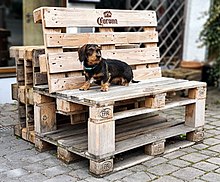
From an ecological point of view, reusable packaging / pallets are a better alternative to one-way systems. Since each one-way pallet is often an individual pallet in terms of dimensions and design, it cannot be used in automatic processes. The reusable pallets are also not subject to waste law, as they can be recycled directly.
Less energy is required for the production and processing of wooden pallets than for plastic pallets. The energy balance of a wooden pallet is significantly more favorable over its entire life cycle. The Dutch institute TNO has carried out a life cycle analysis of a reusable four-way flat pallet made of wood and a comparable pallet made of HDPE (material: 50% new, 50% recycled). The total energy consumption (including recycling) was 4.4 times as high for the plastic pallet as for the wooden pallet. Studies from France and Sweden confirm the extremely favorable energy and environmental balance of wooden pallets. Water consumption and possibly water contamination arise exclusively during the production of the plastic pallet, since no water is required for the wooden pallet. Wood can also be recycled much more easily . Another study comes to a superior ecological balance of wooden pool pallets compared to plastic pool pallets.
Reusable systems
All reusable pallets are usually used in systems that can be divided into three types of action:
Pallet exchange
The pallet exchange started in the 1960s. Its origin lies in factory traffic, where, for example, the miller delivers to the bakery every day and took back the empties. The exchange must be regulated individually, as there are no specific legal bases. In some cases there is also a sales tax liability. The most widespread form is the move-by-move exchange (see Euro pool pallet ).
Pallet purchase
Since the physical return of euro pallets that have not been exchanged step by step can be time-consuming and costly, an alternative is to offset the pallet debts at the current market price. When reselling the pallet, the pallet is no longer regarded as a transport, but as a commodity, with the goods invoiced .
Rental pooling
With rental pooling, the pallets are rented and picked up by the respective pooling partner at the release location. The user pays for the respective pallet circulation (trip). The largest and best-known providers of rental pallets are CHEP and LPR.
Technical details

Europool pallets are based on a basic module of 400 × 600 mm. Pallets of this size are also called 1/4 Euro pallets and correspond to the size of a so-called VDA box (lattice box pallet according to the requirements of the Association of the Automotive Industry ), which plays an important role in the automotive supply industry.
The wooden Europool pallets EPAL / EUR 1 and UIC / EUR , which have been used for many years, measure 800 × 1200 × 144 mm. The board thicknesses are set at 22-25 mm. 78 tested / marked special nails are used for the Europool pallet and connect the 98 components in accordance with EN 13698-1.
The half euro pool pallets with 800 mm × 600 mm are also called display pallets because they can be used as part of displays for the presentation of goods. At EPAL they are called EUR 6 pallets; Another name is Düsseldorfer Palette .
The somewhat larger so-called industrial pallets (1000 × 1200 × 144 mm), which are standardized by EPAL as EUR 3 or in a reinforced version as EUR 2 pallets , are also widespread .
Non-standardized large pallets often have twice the industrial dimensions , i.e. they are 2000 × 1200 mm or 2000 × 1250 mm in size.
Europool pallets do not allow the global standard ISO containers to be fully used , especially since the internal dimensions of these containers may vary by up to 80 mm.
The pallets common on the American continent and partly also in China measure 48 × 40 inches, i.e. with 1219.2 × 1016 mm they roughly correspond to the industrial pallets (1200 × 1000 mm).
In Asia, pallets of 1100 × 1100 mm or 1140 × 1140 × 130 mm are generally used.
In the area of corrugated cardboard pallets, there is an alternative to the so-called lattice boxes. The advantage is that the pallet and the associated container are made of the same material, which makes the disposal of the used transport container very easy and works worldwide without restrictions (wooden pallets must be treated according to IPPC). The use of these pallets also minimizes many dangers for the user (injuries from nails, splinters, etc.). Pallets made of corrugated cardboard can also be produced in a wide variety of shapes (e.g. heart-shaped, round, etc.) without any problems, as the manufacturing process is in Compared to wooden pallets, plastic pallets and pressboard pallets, it is more cost-effective and flexible. That brings especially for the design of POS - displays many design options with them, without limiting the logistical processes.
Pallet boxes
Pallet boxes are pallets with four frames and possibly a lid. In contrast to pallets, pallet boxes can be stacked when they are loaded. In this case, they are sometimes capped to make them more stable. Stacking them enables pallet boxes to use storage space and truck capacity more efficiently. Another advantage of the pallet boxes is that the goods are stored safely and are not damaged during transport. There are also collapsible pallet boxes in which the pallet frames can be laid flat. This way, less space is required to transport them back empty.
Economic aspects in Germany
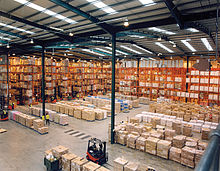
Most of the companies that manufacture pallets and similar packaging (exception, for example, pallets made of corrugated cardboard) are part of the Bundesverband Holzpackmittel, Paletten und Exportverpackung e. V. organized. The companies covered by official statistics (more than 20 employees) achieved sales of around 1.1 billion euros with pallets in 2010. The number of companies rose from 127 to 143 between 1996 and 2010, and the number of employees rose from a good 5,000 to almost 6,500 in the same period. 90% of the turnover was achieved domestically, around 10% of the pallets were exported. A total of around 500 million euro pallets are in circulation worldwide.
See also
- Wooden frame
- Palletizer
- Pallet changer
- Pallet (technology)
- Pallet rack
- Pallet management
- Pallet fork
- Pallet ship
Web links
Individual evidence
- ↑ csc .: Pallet manufacturers are suffering from rising timber prices . In: FAZ of May 23, 2011.
- ↑ Swiss Commercial Vehicle Association: Exit from the pallet exchange .
- ↑ plastic pallets. Retrieved January 14, 2020 .
- ↑ CP pallets for the chemical industry. (PDF; 8 MB) In: Handbook for packaging. VCI - Verband der Chemischen Industrie eV, April 2004, accessed on February 16, 2015 .
- ↑ VMF range. Retrieved February 24, 2018 .
- ↑ Life cycle assessment. HPE - Bundesverband Holzpackmittel, Paletten, Exportverpackung eV, accessed on June 7, 2020 .
- ↑ http://www.world-pallet.com/maerkte-paletten/europa/markt/ The European market
- ^ Jonas Bengtsson, James Logie: Life Cycle Assessment of One-way and Pooled Pallet Alternatives. In: Procedia CIRP 29. ScienceDirect, 2015, pp. 414–419h4 , accessed on June 7, 2020 .
- ↑ http://www.lkwrecht.de/Transport/Palettentausch Palettentausch.
- ↑ http://www.falkenhahn.eu/paletten/logistik-konzept.php Advantages Resale of the pallets.
- ↑ http://www.chep.com/Pallets/ CHEP rental pool / advantages.
- ↑ Pallets in comparison ( Memento from September 28, 2016 in the Internet Archive )
- ↑ see figures from the Federal Statistical Office on the website of the Association Archived Copy ( Memento of the original from July 6, 2007 in the Internet Archive ) Info: The archive link was inserted automatically and has not yet been checked. Please check the original and archive link according to the instructions and then remove this notice.
- ↑ After Oliver Schmale: Die Palettenmacher . In: Frankfurter Allgemeine Zeitung , December 13, 2011, page 18: faz.net .
- ↑ escalesimprobables.com ( Memento of the original from July 26, 2014 in the Internet Archive ) Info: The archive link was inserted automatically and has not yet been checked. Please check the original and archive link according to the instructions and then remove this notice.
swell
- Andreas Könnerling, Manfred Eberhardt, Ognjan Gentschew, Manuela Stelling, Michael Weckbach (eds.): Alles auf Lager , Winklers / Westermann, Braunschweig 2010, ISBN 978-3-8045-5080-3



